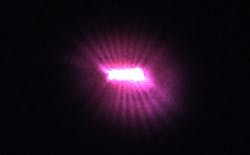IR-emitting room-temperature nanowire lasers are based on gallium arsenide
| When lasing, a gallium arsenide based nanowire produces interference characteristic of two coherent dipole emitters (corresponding to the nanowire ends), leading to this interference pattern. (Image: Australian National University) |
Acton, Australia—Researchers at the Australian National University have created what they say are the first room-temperature lasers from aluminum gallium arsenide (AlGaAs)-based nanowires.1 Nanowire lasers emitting in the UV or visible regions have previously been developed, but IR-emitting nanowire lasers are more difficult to create due to issues such as Auger recombination.
Dhruv Saxena, the lead author of the group’s paper in Nature Photonics, notes that conventional IR-emitting laser diodes are bulky and require many processing steps to produce a good cavity and mirrors. Nanowires are much easier to fabricate; in addition they are minuscule in size, leading to potential benefits such as 3D integration.
Optically pumped
"We have a substrate covered in gold particles which act as catalysts, or seeds," says Sudha Mokkapati, one of the researchers. "We provide gases containing gallium and arsenic and raise the temperature of the substrate up to 750°C. At these temperatures the elements react and nanowires start growing."
"The substrate provides the direction of the [crystal] growth, so they grow straight up, standing vertically on the substrate instead of growing in random directions," says Saxena. The researchers produced nanowires with a GaAs/AlGaAs/GaAs core-shell-cap structure, paying attention to the material quality as well as the design of the nanowires’ Fabry-Perot laser cavities. The lasers are optically pumped; ultimately, electrical pumping would be an advantage for use in optical integrated circuits.
Potential uses of the nanowire lasers include optical communications, spectroscopy, and medical diagnosis.
REFERENCE:
1. Dhruv Saxena et al., Nature Photonics (2013); doi: 10.1038/nphoton.2013.303
